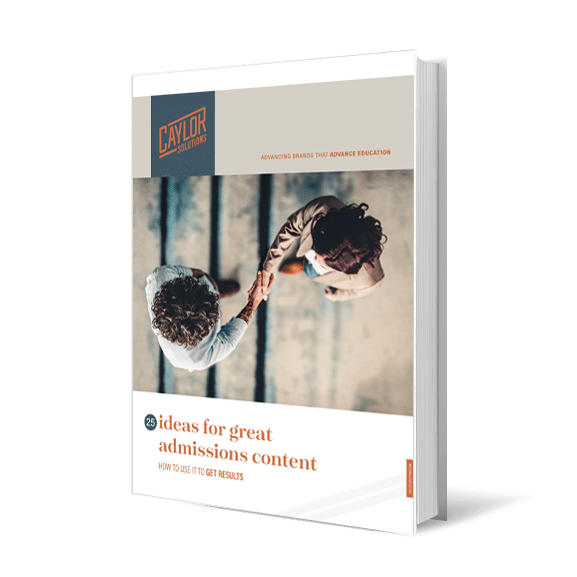Flipping the Funnel: How Direct Admissions is Redefining Enrollment
Learn how direct admissions can simplify recruitment, boost yield, and help marketers connect with students earlier in the funnel.
Marketing Strategies
Adult students have so much to offer for your classes, faculty, and campus life! Let’s dive into content strategies for nontraditional students that will draw them to your school.
Enrollment marketers have always marketed to adult students returning to college, but for the most part, they’re relegated to the “if we get around to it” part of educational marketing strategies.
But after reading this post, I hope you’ll get some renewed energy and excitement for this growing and highly beneficial student demographic!
In this post, we’ll also cover some content strategies for nontraditional students that will help you draw them in to learn more about your private college or university.
According to the National Center for Education Statistics, students aged 25 and older accounted for roughly 40 percent of all college and graduate students in the year 2009. By the year 2020, that number is expected to rise by at least three percent with over 9.6 million non-traditional students heading to college.
Additionally, students over the age of 35, who accounted for 17 percent of all college and graduate students in 2009, are expected to comprise 19 percent of the graduation total by the year 2020.
– Danika McClure
Of course, those predictions were made before the COVID-19 pandemic.
My personal feeling is that if the pre-COVID prediction was 40 percent then we should see anywhere from 5 to 10 percent more growth of adult learners within the next enrollment cycle.
Why? Because millions of working adults are no longer working.
Global lockdowns have shaken our economies, forcing many people to reconsider their current careers and future goals.
They may have lost their job or business, but they still have families to care for and dreams they wish to pursue.
For many, right now is an opportune time to jump into that second career they’ve been thinking about, especially through online courses.
Private institutions are generally more adult learner friendly as they are free to come up with more creative, flexible solutions than large, publicly funded universities typically can.
That means you’re already ahead of the game simply by being you.
Unfortunately, you’ve still got some competition with community colleges which also offer attractive programs for nontraditional students.
This makes your content marketing strategy all the more important as you seek to differentiate yourself and attract more adult learners to your school.
As with any good marketing strategy, you should have a separate marketing persona written for your target nontraditional student.
Making sure they’re included as one of your target audiences will help your team create successful content strategies for nontraditional students for years to come.
It’s important your efforts to enroll adult learners be more than a one-off push.
Marketing has always been a marathon rather than a sprint. Longevity is critical.
Believe it or not, nontraditional students prefer longer-form content.
You’d think they’d be too busy being parents, bosses, or employees to read a 15-page eBook or watch a 5+ minute video.
But the truth is, they are trying to make the right decision for their families – and that means they have to get all the facts.
Being older typically means more responsibilities, but it also means that in general, mature students approach decisions with more caution.

Content strategies for nontraditional students require long-form content.
Most adult learners prefer to spend more time during the discovery and decision-making process.
They’ve got a lot riding on this decision!
In your content strategies for nontraditional students, plan to produce longer-form content such as eBooks, slightly longer video content geared for their needs, and email nurturing campaigns.
In order for your content strategies for nontraditional students to work, you’ve got to create content that answers their questions about your school, their new career, and even the decision itself.
Just as important is that you answer their questions through more than one content piece and through more than one content medium.
As enrollment marketers, it’s easy to get tired of answering the same questions over and over – but for many of those in your audience, these questions are coming up for the first time.
You can’t assume that your prospective student read the eBook that you published. So make sure you’re sharing the download link in your email campaigns, blog posts, print marketing, etc.
Here are some of the most common questions your content strategies for nontraditional students should answer:
Honesty and transparency are the best policy. So make sure your fee structure is clear.
You can gain loads of trust with nontraditional students by placing the bottom-line cost of each program or degree clearly for them to consider.
That said, make sure you show how sound of a financial investment your program is.
You can do this by helping them calculate their potential earning power after completing your program, showing them your graduates’ hiring success rates, and sharing adult learner testimonies.
Time is even more valuable than money.
Show your audience how flexible your programs are and how other students like them have made their academic journey work around their busy schedules.
Again, transparency is key. Some nontraditional students might not know how to calculate the time commitment for a specific course just by looking at the credit hours.
One way to clear up the confusion is by placing a weekly time estimate in your content. You can also ask graduates to share in their testimonies just how much time they studied daily or weekly.
Some schools allow students to complete their entire degree online. Others require a short residency on campus.
Special programs might even require travel to certain locations for on-site training, mission trips, or networking.
Nontraditional students have many commitments they’re juggling all at the same time. In your marketing content, tell your audience if any travel to the campus or other location is required.
If you don’t have any way for nontraditional students to try out your programs, I highly recommend that you put together a sample course for free or for a highly discounted rate that they can take online.
Carolina College of Biblical Studies does a fantastic job using this strategy by offering potential students their “How to Study the Bible” class tuition-free!
You can also open up sample courses by allowing nontraditional students to audit classes.
This one is fairly obvious, but it’s important to list it here.
Nontraditional students tend to know exactly what they want. They’ve been around the block. They’ve worked a few jobs.
Most importantly, they have a better understanding of who they are and how the market works.
This is why you want your content strategies for nontraditional students to take their time in explaining your majors and what the adult learner will get out of them.
Nontraditional students care much more about your academic programs than campus life, classmate relationships, and other kinds of experiences.
So it’s critical to create content that spells out your programs and if nontraditional students can complete them on their own schedule and budget.
Keep in mind that content should be SEO friendly.
Build on your content over time so that you can rank well for multiple keyword phrases since nontraditional students typically start with a Google search on the particular program they are looking for (which makes keywords so important!) and then choose the school.
Unlike traditional students, adult learners not only come in with work experience, they come in with life experience.
If they are choosing a program within their current field, offer experience credits for the years they’ve already invested in the school of “hard knocks.”
The stats are in. More and more adults everywhere are looking for ways to go back to school and level up on their careers.
This means your content strategies for nontraditional students are more important than ever.
Take the time to create your strategy, develop the content, and invest in these incredible students.
And if you need help working out the kinks in your marketing for nontraditional students, or to get better results out of your enrollment marketing overall, contact us today!
You’re in luck! We’ve curated 25 awesome ideas inspired by top higher ed institutions across the country and put them in one handy guide: 25 Ideas for Great Admissions Content.

Get inspired.
Get enrollment results.
Get 25 Ideas for Great Admissions Content.
Download your copy today!
Featured image by Monkey Business via Adobe Stock
Woman studying in library image by Ermolaev Alexandr via Adobe Stock
Subscribe to The Higher Ed Marketer podcast today!